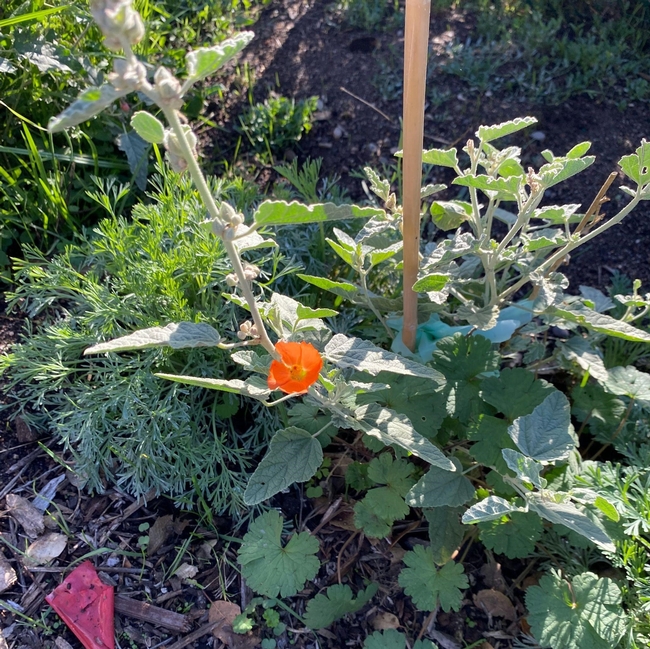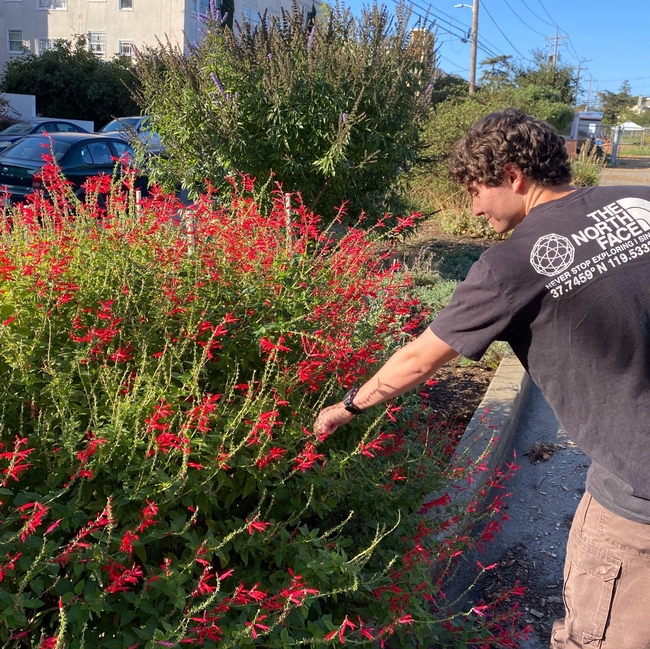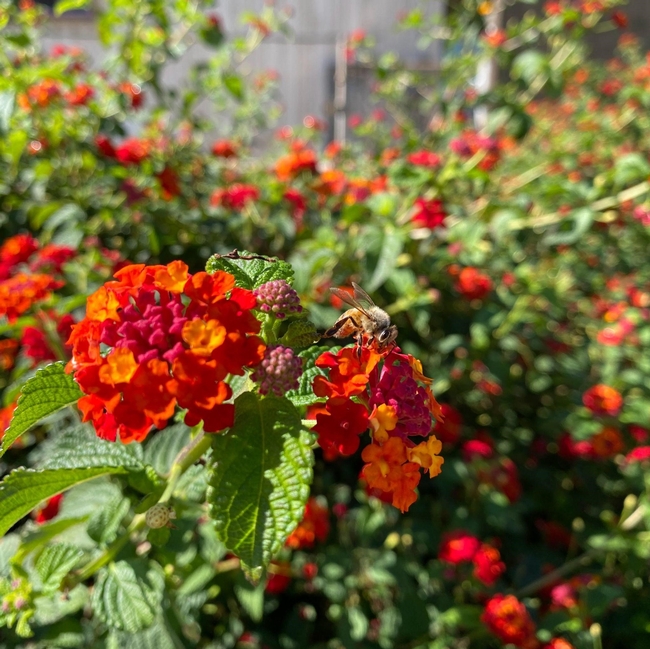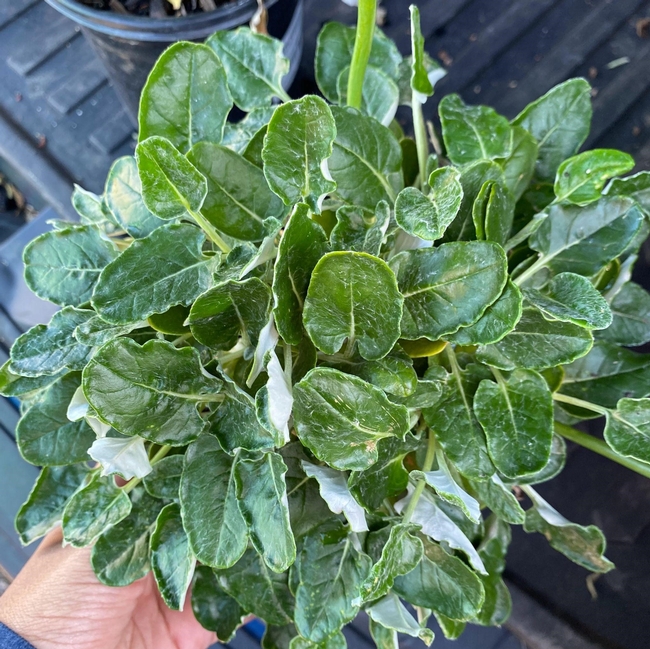The California Department of Food and Agriculture's Healthy Soil Program provides funding for on-farm initiatives aimed at implementing soil practices that reduce greenhouse gas emissions and enhance carbon storage. The UC Hopland Healthy Soils Project was created in collaboration with the Hopland Research and Extension Center (HREC) and undertaken by UC Berkeley's Dr. Gordon Frankie to assess the impact of various hedgerow plant species on pollinator diversity. Hedgerows typically consist of shrubs, trees, grasses, and flowering plants that offer various advantages to the surrounding farm ecosystem. These advantages include but are not limited to: weed control, windbreak, erosion control, improved air and water quality, biodiversity enhancement, and increased pollinator activity.
To measure the effect of the hedgerows on pollinator activity, Dr. Frankie and his team at the UC Berkeley Urban Bee Lab conduct bee surveys on both the treatment area (hedgerow) and the control area (weeds and grasses) four times a year during spring, summer, and fall. The ultimate objective of this project is to strike an ecological balance by selecting plant species that benefit a range of organisms such as bees, birds, butterflies, and others, while simultaneously mitigating greenhouse gas emissions and sequestering carbon in the farm soil.
Assistant Researcher Jerid Vega with Pineapple Sage (Salvia elegans) at the Urban Bee Lab Garden in Berkeley, CA
Dr. Frankie, with the UC Berkeley Department of Environmental Science, Policy, and Management, is an urban entomologist with over 25 years of experience focusing on the behavioral ecology and community organization of solitary bee species in specific environments within California and Costa Rica. Over the past two decades, Dr. Frankie has conducted extensive studies on bee diversity, seasonality, and host plant preferences at various sites in northern California and seasonal dry forests in Costa Rica. His research also involves monitoring changes in annual bee frequencies and mortality factors that may impact bee populations. Recently, Dr. Frankie's work has shifted from pure wildland studies to comparative bee studies in both wildlands and urban residential gardens, driven by the discovery that urban areas can support diverse local bee species. This shift aligns with a broader concern of global pollinator decline and the need to find new ways to conserve and protect pollinators across different habitats.
A pollinator visiting Lantana or Shrub Verbena (Lantana camara) at the Urban Bee Lab Garden in Berkeley, CA
Dr. Frankie and his assistant researcher Jerid Vega recently stopped by HREC to add herbaceous plants and flower seeds to their project's test hedgerow. Jerid graduated from Berkeley in the spring of 2023 with a B.S. in Molecular Biology from UC Berkeley's College of Natural Resources. Both Dr. Frankie and Jerid argue there is inherent value in recognizing what biodiversity is. “Supporting that biodiversity can be achieved through investments in smaller, more pollinator friendly gardens” says Vega.
Admittedly, Dr. Frankie acknowledges that picking plants for the hedgerow and observing their relationships with pollinator visitors is a very slow process. The time it takes for plant species to establish can be an obstacle to speedy species surveying. When asked how their research team selects and manages the plant species for a specific project, Dr. Frankie and Jerid credit nursery workers, master gardeners, and community members for their suggestions. Dr. Frankie's ideology on plant selection is collective, the product of conversation about pollinator activity from his team, colleagues, and master gardeners. “Those are the people who spend time with the plants, watching them far more than I do!” Dr. Frankie chimes.
Urban Bee Lab Garden in Berkeley, CA

The Desert Mallow and native Redflower Buckwheat (pictured below) are just two of the many plant species that Dr. Frankie and his research team are in the process of observing. These native wildflowers not only produce striking, colorful blooms but also offer a wealth of nectar and pollen, making them a valuable food source for bees, butterflies, and other beneficial insects. Their extended blooming periods, typically from spring through late summer, ensure a consistent supply of sustenance for pollinators throughout the season. Additionally, both plants are well-adapted to arid and semi-arid regions, making them resilient and low-maintenance choices for gardeners. The Desert Mallow and Redflower Buckwheat exemplify the harmonious relationship between native plants and their pollinator counterparts that enhances biodiversity and contributes to a healthier ecosystem.
It's important to recognize that these pretty flowers attract all kinds of insects that aren't as suitable to some as the docile hummingbird. “It's not just bumble bees that these plants attract, it's wasps and flies that do their own part in benefiting ecosystem biodiversity,” adds Jerid Vega. The myth of insect pollinators being inherently eager to sting humans can be a significant obstacle in the way of convincing people to plant pollinator-friendly gardens. This fear of insects perpetuates reluctance to support both wildland and urban insect populations. In reality, these insects are not naturally aggressive toward people. “They're primarily focused on foraging for nectar/pollen to feed their colonies, and will only sting as a last resort if they feel threatened or cornered” concludes Jerid.
Educating people about the behavior and importance of bees and other pollinators is crucial. Dispelling the myth that bees are out to sting us can encourage more individuals to embrace pollinator-attracting plants, contributing to the conservation of these vital species. Understanding the true nature of bees and their role in pollination can lead to a more harmonious coexistence between humans and these remarkable insects.
When asked what potential small gardens with pollinator-preferred species have to attract a high diversity of bee species, Dr. Frankie provided some examples of encouraging results starting with his lab at the Oxford Tract. When the Bee Lab first moved to this site off campus, they started with bare soil. Since moving there full time in 2020, the garden has attracted over sixty species of native bees. The Bee Lab has also consulted on community gardens outside of the Bay Area in the past, including Emerson Community Garden in San Luis Obispo and a Diverse Home Garden in Ukiah. Emerson Community Garden surveyed 5 native bee species pre-planting and 42 species post-establishment. Diverse Home Garden in Ukiah surpassed that of Emerson, surveying 65 bee species in total over the course of 12 years.
The Bee Lab does their work with the help of community educators and a select group of volunteers primarily composed of undergraduate students interested in entomology, resource studies, or environmental conservation. Dr. Frankie's team sifts through volunteer applications annually, and are attracted to students they know will stay on board and have an interest in community outreach. Despite The Bee Lab being a small non-profit entity, they still respond to any invitations they can asking for lessons about pollinator vs. plant relationships.
Learn more about the UC Berkeley Bee Lab here.
This project was supported by funding through the CDFA's Healthy Soils Demonstration Program and 'California Climate Investments'. The HREC Hedgerow Demonstration Project is part of California Climate Investments, a statewide initiative that puts billions of Cap-and-Trade dollars to work reducing greenhouse gas emissions, strengthening the economy, and improving public health and the environment - particularly in disadvantaged communities.


